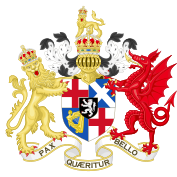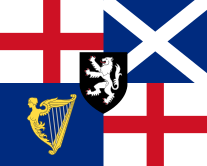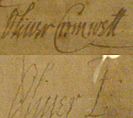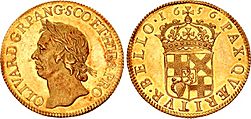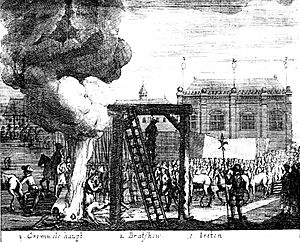Oliver Cromwell facts for kids
Quick facts for kids
Oliver Cromwell
|
|
|---|---|

Portrait by Samuel Cooper, 1656
|
|
| Lord Protector of the Commonwealth of England, Scotland and Ireland | |
| In office 16 December 1653 – 3 September 1658 |
|
| Preceded by | Council of State |
| Succeeded by | Richard Cromwell |
| Member of Parliament for Cambridge |
|
| In office 30 February 1640 – 20 January 1649 |
|
| Monarch | Charles I |
| Preceded by | Thomas Purchase |
| Member of Parliament for Huntingdon |
|
| In office 31 January 1628 – 2 March 1629 |
|
| Monarch | Charles I |
| Preceded by | Arthur Mainwaring |
| Personal details | |
| Born | 25 April 1599 Huntingdon, Huntingdonshire, England |
| Died | 3 September 1658 (aged 59) Palace of Whitehall, City of Westminster, England |
| Resting place | Sidney Sussex College, Cambridge (Head) |
| Spouse | |
| Children |
|
| Parents |
|
| Alma mater | Sidney Sussex College, Cambridge |
| Occupation | Soldier and statesman |
| Signature | |
| Nicknames |
|
| Military service | |
| Allegiance | Kingdom of England (pre-1642) Parliamentarian (1642–1651) Commonwealth of England, Scotland and Ireland (1651–1658) |
| Branch/service |
|
| Years of service | pre-1642 (militia service) 1642–1651 (civil war) |
| Rank |
|
| Commands |
|
| Battles/wars | |
Oliver Cromwell (born 25 April 1599 – died 3 September 1658) was an important English politician and soldier. Many people see him as one of the most significant leaders in English history. He became famous during the Wars of the Three Kingdoms (1639-1653). First, he was a top commander in the Parliamentary army. Later, he became a powerful politician.
Cromwell strongly supported the decision to remove King Charles I from power in January 1649. This led to the creation of a new government called The Protectorate. Cromwell then ruled as Lord Protector from December 1653 until his death in September 1658. However, Cromwell is still a debated figure in Britain and Ireland. This is because he used the army to gain and keep power, and because of his harsh actions during his 1649 campaign in Ireland.
Cromwell studied at Sidney Sussex College, Cambridge. In 1628, he was elected as a MP for Huntingdon. For the first 40 years of his life, he was not very well known. At one point, he even thought about moving to New England. In the 1630s, he became a religious Independent. After this, he believed his successes were guided by God. He generally supported religious freedom for different Protestant groups. However, he later opposed groups he thought were teaching wrong ideas, like Quakers.
In 1640, Cromwell became an MP for Cambridge in both the Short Parliament and Long Parliament. When the First English Civil War started in August 1642, he joined the Parliamentarian army. He quickly showed his military skills. In 1645, he became the commander of the New Model Army cavalry under Sir Thomas Fairfax. He played a key role in defeating the Royalists in the First and Second English Civil Wars.
After King Charles I was removed from power and his son Charles II went into exile, Cromwell led successful military campaigns. He won victories in Ireland and against the Scots from 1649 to 1651. These wins firmly established the Commonwealth and Cromwell's power in the new government. In December 1653, he was named Lord Protector. He held this position until his death in September 1658. His son Richard took over, but he was not strong enough to keep control. This led to a power vacuum. In 1660, Charles II returned to the throne in what was called the Stuart Restoration. After this, Cromwell's body was removed from Westminster Abbey and put on display. His head was placed on a spike outside the Tower of London for 30 years before being reburied at Sidney Sussex College, Cambridge.
People have very different opinions about Cromwell. Winston Churchill called him a military dictator. Others, like John Milton and Thomas Carlyle, saw him as a hero of freedom. The discussion about his place in history continues today. A statue of him outside the Houses of Parliament was first suggested in 1856. It was finally put up in 1895, mostly paid for by Lord Rosebery, who was Prime Minister at the time.
Contents
- Cromwell's Early Life and Education
- Cromwell as a Member of Parliament
- Cromwell as a Military Commander
- Cromwell's Role in Politics: 1647–1649
- The Commonwealth of England: 1649
- Cromwell's Campaign in Ireland: 1649–1650
- Cromwell's Scottish Campaign: 1650–1651
- Cromwell's Return to England and Parliament
- The Barebone's Parliament: 1653
- Cromwell as Lord Protector: 1653–1658
- Cromwell's Death and Posthumous Events
- Cromwell's Historical Reputation
- Monuments and Honors for Cromwell
- Images for kids
- See also
Cromwell's Early Life and Education
Oliver Cromwell was born in Huntingdon on 25 April 1599. His parents were Robert Cromwell and Elizabeth Steward. His family was part of the landed gentry, meaning they owned land. Cromwell's father had a modest income, but the family was still respected. In 1654, Cromwell said, "I was by birth a gentleman, living neither in considerable height, nor yet in obscurity."
Oliver was baptized on 29 April 1599 at St John's Church. He went to Huntingdon Grammar School. Then, he studied at Sidney Sussex College, Cambridge. This college was new and had strong Puritan beliefs. He left in June 1617 without finishing his degree, right after his father died. He likely returned home to help his widowed mother and seven unmarried sisters.
Cromwell's Marriage and Family Life
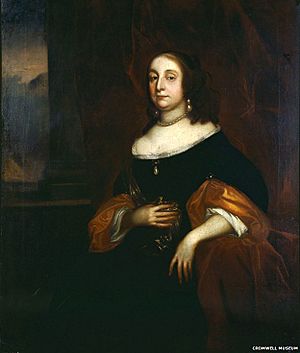
Cromwell married Elizabeth Bourchier (1598–1665) on 22 August 1620 in London. Elizabeth's father was a wealthy merchant with land in Essex. This marriage connected Cromwell to important Puritan families and leaders. These connections helped his military and political career greatly.
Oliver and Elizabeth had nine children:
- Robert (1621–1639), who died at school.
- Oliver (1622–1644), who died from typhoid fever while serving in the army.
- Bridget (1624–1662).
- Richard (1626–1712), who became Lord Protector after his father.
- Henry (1628–1674), who later became Lord Deputy of Ireland.
- Elizabeth (1629–1658).
- James (born and died 1632), who died as a baby.
- Mary (1637–1713).
- Frances (1638–1720).
Changes in Cromwell's Beliefs
Not much is known about Cromwell's early religious beliefs. However, he went through a personal crisis in the late 1620s and early 1630s. In 1628, he was elected to Parliament for Huntingdon. Later, he sought treatment for depression. In 1629, he got into a dispute in Huntingdon and was called before the Privy Council.
In 1631, Cromwell sold most of his property in Huntingdon and moved to a farm in nearby St Ives. This was a big change for his family. A letter from 1638 shows his spiritual awakening during this time. He described himself as a "chief of sinners" who was saved by God's mercy. This letter also shows his Independent beliefs. He felt the Reformation had not gone far enough and that England still needed to remove Catholic practices from the church. In 1634, Cromwell tried to move to America, but the government stopped him.
By 1636, Cromwell inherited property in Ely from his uncle. This increased his income, and he returned to being a recognized gentleman. He became a strong Puritan and had important family ties to leading families in London and Essex.
Cromwell as a Member of Parliament
Cromwell first became a Member of Parliament for Huntingdon in 1628. He didn't make much of an impact then. After this Parliament, King Charles I ruled without Parliament for 11 years. In 1640, the King needed money to fight a Scottish rebellion. He called a Parliament, known as the Short Parliament, which only lasted three weeks. Cromwell was elected for Cambridge in this Parliament.
Later that same year, a second Parliament was called, known as the Long Parliament. Cromwell was again elected for Cambridge. He likely got his position through the support of others. In the first week, he helped present a request for the release of John Lilburne, a Puritan who had been arrested. For the first two years of the Long Parliament, Cromwell was connected to a group of religious aristocrats and MPs. This group wanted reforms, such as regular parliaments to check the King's power and more religious freedom. Cromwell supported these efforts, helping to draft bills for annual parliaments and to remove bishops from the church.
Cromwell as a Military Commander
The Start of the English Civil War
The disagreements in the Long Parliament led to fighting between Parliament and King Charles I in late 1642. This was the start of the English Civil War. Before joining Parliament's forces, Cromwell only had experience in the local militia. He gathered a cavalry troop in Cambridgeshire. He stopped a valuable shipment of silver from Cambridge colleges that was meant for the King. Cromwell and his troop arrived too late for the Battle of Edgehill in October 1642. His troop became a full regiment in the winter of 1642–43, part of the Eastern Association army. Cromwell gained experience in successful battles in East Anglia in 1643, like the Battle of Gainsborough in July. He was then made governor of the Isle of Ely and a colonel.
Victory at Marston Moor in 1644
By the time of the Battle of Marston Moor in July 1644, Cromwell was a lieutenant general in the army. His cavalry helped Parliament win a major victory. They broke through the Royalist cavalry and then attacked their infantry from behind. Cromwell fought at the front of his troops and was slightly wounded. Marston Moor secured northern England for Parliament, but the Royalists still resisted.
The war continued without a clear end in sight. Cromwell had a serious disagreement with his commander, the Earl of Manchester, after the Second Battle of Newbury in October. Cromwell felt Manchester was not fighting hard enough. Manchester accused Cromwell of choosing officers from "low birth." Cromwell replied that he would rather have a "plain russet-coated captain who knows what he fights for" than a gentleman who was nothing else.
The New Model Army
To better fight the war, Parliament created the New Model Army in early 1645. This army was organized on a national basis, replacing older local forces. Cromwell played a big part in these changes. Parliament also passed the Self-denying Ordinance. This law made members of Parliament choose between their government jobs and military command. Everyone except Cromwell chose to give up their military roles. Cromwell's command was extended. In April 1645, the New Model Army took the field with Sir Thomas Fairfax in charge and Cromwell as Lieutenant-General of cavalry.
The Battle of Naseby in 1645

At the important Battle of Naseby in June 1645, the New Model Army crushed the King's main army. Cromwell again led his cavalry wing to great success, defeating the Royalist cavalry. At the Battle of Langport on 10 July, Cromwell helped defeat the last large Royalist field army. These battles ended the King's hopes of winning. Parliament then took over the remaining Royalist strongholds in western England. In October 1645, Cromwell besieged and captured the wealthy Catholic fortress of Basing House. He was later accused of killing many of its defenders after they surrendered. He also took part in successful sieges at other towns. King Charles I surrendered to the Scots on 5 May 1646, which ended the First English Civil War.
Cromwell's Military Approach
Cromwell did not have formal military training like Fairfax. He used a common cavalry tactic of riding in three ranks and charging forward, relying on impact. His strengths were his natural ability to lead and train his soldiers, and his strong moral authority. In a war fought mostly by people without much experience, these strengths were very important. They likely helped keep his cavalry disciplined.
Cromwell used cavalry formations where troopers rode very close together, knee to knee. This was new in England at the time and helped his success. He kept his troops together after small fights instead of letting them chase enemies far away. This allowed them to fight again quickly and react to changes in battle. This command style was key at both Marston Moor and Naseby.
Cromwell's Role in Politics: 1647–1649
In early 1647, Cromwell was ill for over a month. When he recovered, Parliament was divided over what to do with the King. Many wanted to pay off the Scottish army, reduce the New Model Army, and bring back Charles I in exchange for a Presbyterian church system. Cromwell did not like the Scottish Presbyterian system because he felt it would replace one strict system with another. The New Model Army, which was not being paid, protested these changes. Parliament declared their protest illegal. In May 1647, Cromwell tried to negotiate with the army but failed.
In June 1647, some cavalry soldiers took the King from Parliament's custody. With the King now with the army, Cromwell wanted to know what conditions the King would accept to regain power. The King seemed willing to compromise. So, Cromwell's son-in-law, Henry Ireton, wrote proposals for a new government. These "Heads of Proposals" aimed to limit the King's power, set up regular parliaments, and allow a non-mandatory Episcopalian church.
Many in the army, like the Levellers, felt these proposals were not enough. They wanted full political equality for all men. This led to intense debates in Putney in late 1647 between Cromwell and Ireton on one side, and Levellers like Colonel Rainsborough on the other. The Putney Debates ended without a clear solution.
The Second Civil War
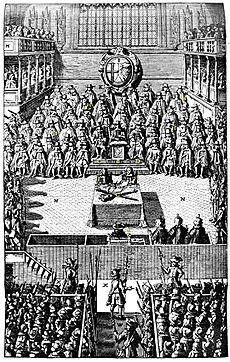
The failure to reach an agreement with the King led to the Second English Civil War in 1648. The King tried to regain power by force. Cromwell first put down a Royalist uprising in south Wales. He then marched north to deal with a Scottish army that had invaded England to support the King. At Preston, Cromwell was in sole command for the first time. With 9,000 soldiers, he won a major victory against an army twice his size.
During 1648, Cromwell's letters and speeches often used ideas from the Bible. He believed that God was guiding events and that the army was God's chosen tool. He saw victories as signs of God's approval. This belief in Providentialism—that God actively directs the world—was very important to Cromwell.
The King's Trial and Execution
In December 1648, an event known as Pride's Purge happened. Soldiers removed all MPs from the Long Parliament who did not support the army leaders. The remaining MPs, called the Rump Parliament, agreed that Charles I should be tried for treason. Cromwell returned to London and strongly supported the King's trial and execution. He believed that removing Charles was the only way to end the civil wars.
Charles I's death warrant was signed by 59 members of the court, including Cromwell. Executing the King was a very controversial act, especially because of the idea of the divine right of kings. Charles I was executed on 30 January 1649.
The Commonwealth of England: 1649
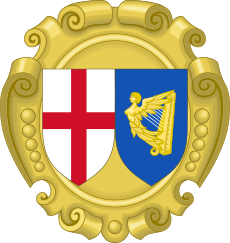
After the King's execution, England became a republic called the Commonwealth of England. The "Rump Parliament" held power, with a smaller Council of State handling some executive duties. Cromwell was a member of both. In the early months, Cromwell tried to unite different groups, but it was difficult.
Meanwhile, the Royalists had regrouped in Ireland, forming an alliance with Irish Catholics. In March, Parliament chose Cromwell to lead a campaign against them. Cromwell also faced political disagreements within the New Model Army. The Levellers wanted more equality and religious tolerance for all men. Cromwell and other leaders disagreed, believing that only landowners should vote. Rebellions and mutinies followed these debates. Cromwell helped put down these uprisings. In July, he left for Ireland.
Cromwell's Campaign in Ireland: 1649–1650
Cromwell led Parliament's invasion of Ireland from 1649 to 1650. The main threat was an alliance between Irish Confederate Catholics and English Royalists. Cromwell saw this as the biggest danger to the Commonwealth. He also had strong religious opposition to the Catholic Church, which he blamed for persecution of Protestants in Europe. The Irish Rebellion of 1641, where Protestant settlers were killed, also fueled his hostility.
Parliament had planned to conquer Ireland since 1641. Cromwell's invasion in 1649 was much larger and better supplied. His nine-month campaign was quick and effective, though it did not end the war entirely. When he arrived in August 1649, Parliament only held outposts in Dublin and Derry. When he left, they controlled most of eastern and northern Ireland.
After landing in Dublin, Cromwell captured the fortified port towns of Drogheda and Wexford to secure supplies from England. At the Siege of Drogheda in September 1649, his troops killed nearly 3,500 people after taking the town. This included soldiers and some civilians. At the Siege of Wexford in October, another massacre occurred. While Cromwell was trying to negotiate a surrender, some of his soldiers broke into the town, killing many Irish troops and civilians.
After Drogheda, Cromwell sent troops north to Ulster and besieged towns in the south-east like Waterford, Kilkenny, and Clonmel. Kilkenny and other towns surrendered on terms. However, Cromwell failed to take Waterford. At the siege of Clonmel in May 1650, he lost many men before the town surrendered.
One of Cromwell's key successes in Ireland was diplomatic. He convinced Protestant Royalist troops in Cork to switch sides and fight for Parliament. At this point, Cromwell learned that Charles II had landed in Scotland and been declared King. Cromwell returned to England in May 1650 to deal with this new threat.
The Parliamentarian conquest of Ireland continued for almost three years after Cromwell left. Catholic-owned land was taken and given to English and Scottish settlers, Parliament's creditors, and soldiers. Public practice of Roman Catholicism was banned.
Debates About Cromwell's Actions in Ireland
Historians still debate how harsh Cromwell's actions in Ireland were. Some argue he only acted against those fighting him, not civilians. Others point to his reports, which mention the killing of soldiers and "many inhabitants." Cromwell justified the actions at Drogheda as revenge for massacres of Protestants in 1641. However, many of Drogheda's defenders were English Royalists, not the original rebels.
The killings at Drogheda and Wexford were harsh, even for the time. There were few similar events during the Civil Wars in England or Scotland. Cromwell himself stated that he ordered his troops not to spare anyone who was fighting in Drogheda after the town refused to surrender. Under the military rules of the time, a town that refused to surrender after its walls were breached was not guaranteed mercy. When Cromwell negotiated surrenders, as at Carlow and New Ross, he generally respected the terms. At Wexford, some of his troops began killing and looting during negotiations, causing confusion.
Cromwell's time in Ireland was short, but he is often at the center of discussions about whether the Commonwealth carried out a deliberate program of ethnic cleansing. Facing an Irish alliance with Charles II, Cromwell used strong force to subdue the Irish. After he left, other generals continued the campaign, which included burning crops and causing starvation. Estimates of deaths during this period vary widely.
Cromwell's views on Ireland are seen in his 1650 Declaration. He was very critical of Catholicism, stating he would not allow the practice of Mass where he had power. However, he also wrote that if people "walk honestly and peaceably," they should not suffer for their religious beliefs.
Today, Cromwell's actions in Ireland are still remembered with strong feelings.
Cromwell's Scottish Campaign: 1650–1651
Scots Declare Charles II as King
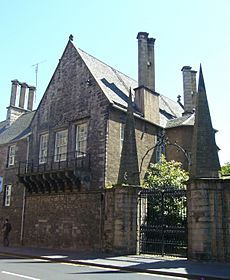
Cromwell left Ireland in May 1650. A few months later, he invaded Scotland because the Scots had declared Charles II (son of Charles I) as their King. Cromwell was less hostile towards Scottish Presbyterians than to Irish Catholics. He saw the Scots as people who feared God, even if they were "deceived." He famously asked the General Assembly of the Church of Scotland to reconsider their support for Charles II, saying, "I beseech you, in the bowels of Christ, think it possible you may be mistaken." The Scots refused, believing their religion was correct. This led Cromwell to believe war was necessary.
The Battle of Dunbar
After his appeal was rejected, Cromwell's experienced troops invaded Scotland. At first, the campaign was difficult. Cromwell's men lacked supplies and faced strong Scottish defenses. Sickness spread among his soldiers. Cromwell was close to evacuating his army by sea from Dunbar. However, on 3 September 1650, Cromwell unexpectedly defeated the main Scottish army at the Battle of Dunbar. He killed 4,000 Scottish soldiers, took 10,000 prisoner, and captured Edinburgh, the Scottish capital. Cromwell called this victory "A high act of the Lord's Providence."
The Battle of Worcester
The next year, Charles II and his Scottish allies tried to invade England and capture London while Cromwell was still in Scotland. Cromwell followed them south. On 3 September 1651, his forces destroyed the last major Scottish Royalist army at the Battle of Worcester. Charles II barely escaped capture and fled to France and the Netherlands, where he stayed until 1660.
At Worcester, Cromwell planned a complex attack. His forces attacked from three directions, divided by two rivers. He moved his reserve troops back and forth across the River Severn to support different parts of the battle. This battle showed Cromwell's skill in moving his forces during a fight.
The End of the Scottish Campaign
In the final stages of the Scottish campaign, Cromwell's men captured Dundee, killing many people. Scotland was then ruled by England during the Commonwealth period. It was kept under military control, with forts blocking off the Highlands. Presbyterianism was still allowed, but the Scottish Church no longer had the same legal power.
Cromwell's conquest did not leave a lasting feeling of bitterness in Scotland. The rule of the Commonwealth was mostly peaceful, except in the Highlands. There were no widespread seizures of land. Most local officials in Scotland were Scots, and the country was governed by English military authorities and a Scottish Council of State.
Cromwell's Return to England and Parliament
Cromwell was away fighting from mid-1649 until 1651. During this time, the different groups in Parliament began to argue among themselves, as the King was no longer a common enemy. Cromwell tried to get the Rump Parliament to set dates for new elections. He also wanted to unite the three kingdoms (England, Scotland, and Ireland) under one government and create a tolerant national church. However, Parliament delayed setting election dates. While they did allow some religious freedom, they did not make other religious changes Cromwell wanted.
According to some accounts, Cromwell began to think about becoming King himself around this time, though this is debated. Eventually, he demanded that the Rump Parliament create a temporary government and then step down. But Parliament started debating its own bill for a new government instead. Cromwell was so angry that he entered the chamber with about 40 soldiers and dissolved Parliament by force on 20 April 1653. He is said to have declared, "you are no Parliament, I say you are no Parliament; I will put an end to your sitting." He also took the ceremonial mace, a symbol of Parliament's power, and demanded it be taken away.
The Barebone's Parliament: 1653
After the Rump Parliament was dissolved, power temporarily went to a council. They discussed what the new government should look like. They liked a suggestion for an assembly of religious men. Cromwell was drawn to the idea of an assembly chosen for their strong religious beliefs. In his speech opening the assembly on 4 July 1653, Cromwell thanked God for bringing England to this point and spoke of their divine mission.
This assembly was called the Nominated Assembly, or sometimes the Parliament of Saints. It was more commonly and negatively called Barebone's Parliament, after one of its members, Praise-God Barebone. Its job was to find a lasting government and religious solution. Cromwell was invited to be a member but declined. However, many members turned out to be radical religious groups. Fearing what these radicals might do, the members voted to dissolve the assembly on 12 December 1653.
Cromwell as Lord Protector: 1653–1658
After Barebone's Parliament dissolved, John Lambert proposed a new constitution called the Instrument of Government. This made Cromwell Lord Protector for life, giving him the main leadership role. Cromwell was sworn in on 16 December 1653. He wore plain black clothes, not royal robes. From then on, Cromwell signed his name 'Oliver P', with 'P' standing for 'Protector', similar to how monarchs signed with 'R' for 'Rex' or 'Regina'. People soon started calling him "Your Highness." As Protector, he could call and dissolve parliaments, but he had to get the majority vote of a Council of State. Cromwell's power was also strong because the army supported him. He was paid £100,000 a year.
Cromwell had two main goals as Lord Protector. The first was to "heal and settle" the nation after the civil wars and the King's execution. This meant creating a stable government. Cromwell believed that social priorities were more important than the exact form of government. He wanted to restore order to English politics. Taxes were slightly reduced, and peace was made with the Dutch, ending the First Anglo-Dutch War.
England's lands overseas, like Newfoundland and colonies in the West Indies, mostly managed their own affairs. Cromwell only stepped in when needed. Virginia was the most unhappy with Cromwell's rule, and many Royalists moved there during this time.
Cromwell emphasized restoring order in his speech to the First Protectorate Parliament on 3 September 1654. He said "healing and settling" was their main goal. However, Parliament quickly became dominated by those who wanted more radical, republican changes. Cromwell dissolved them on 22 January 1655. This Parliament had rules about who could vote, generally requiring a certain amount of property.
Cromwell's second goal was to improve the nation's morals and religious life. He wanted to allow religious freedom and encourage godliness throughout England. He set up groups to check if future church ministers were suitable and to remove those who were not. These groups were meant to lead Cromwell's religious reforms.
After a Royalist uprising in March 1655, Cromwell divided England into military districts. These were ruled by army major generals who reported only to him. These 15 major generals were important for national security and for Cromwell's mission to reform the nation's morals. They oversaw local militias, collected taxes, and ensured support for the government. However, the major generals lasted less than a year. Many people feared they would create a permanent military state. Their actions also brought back bad feelings from the 1640s.
In late 1654, Cromwell launched a military plan called the Western Design against the Spanish West Indies. In May 1655, he captured Jamaica.
As Lord Protector, Cromwell knew that the Jewish community played a big role in the economy of the Netherlands, England's main trading rival. This, along with his tolerance for private worship, led him to encourage Jews to return to England in 1657. They had been banished by Edward I over 350 years earlier. Cromwell hoped they would help England's economy recover after the Civil Wars. He also had a religious reason: he hoped they would convert to Christianity, which he believed would speed up the Second Coming of Jesus Christ.
In 1657, Parliament offered Cromwell the crown. This was a difficult decision for him, as he had helped get rid of the monarchy. Cromwell thought about it for six weeks. He was attracted by the idea of stability that a monarchy could bring. But in a speech on 13 April 1657, he said that God had already shown disapproval of the King's office. He stated, "I would not seek to set up that which Providence hath destroyed."
Instead, Cromwell was formally re-installed as Lord Protector on 26 June 1657 at Westminster Hall. He sat on King Edward's Chair, which was brought from Westminster Abbey. The event was like a coronation, using many royal symbols like a purple robe, a sword, and a scepter (but no crown). The office of Lord Protector was still not hereditary, but Cromwell could now choose his successor. His new powers were outlined in the Humble Petition and Advice. This new constitution brought back some parts of the old system, including a house of life peers (like the House of Lords). Cromwell also started to act more like a monarch, creating three new peerages.
Cromwell's Death and Posthumous Events
Cromwell is believed to have suffered from malaria and kidney stone disease. In 1658, he had a sudden attack of malarial fever. He refused to take quinine, the only known treatment, because it had been discovered by Catholic Jesuit missionaries. This was followed by symptoms of a kidney problem. His health may have worsened after his daughter Elizabeth Claypole died in August.
Oliver Cromwell died at age 59 at Whitehall on 3 September 1658. This was the anniversary of his great victories at Dunbar and Worcester. A big storm swept across England and Europe the night he died. The most likely cause of death was sepsis (blood poisoning) from his urinary infection. He was buried with a grand funeral at Westminster Abbey, similar to that of James I.
Cromwell was succeeded as Lord Protector by his son Richard. However, Richard did not have strong support in Parliament or the Army. He was forced to resign in May 1659, which ended the Protectorate. There was no clear leader among the different groups vying for power. So, George Monck marched on London with army regiments and brought back the Long Parliament. With Monck's guidance, changes were made so that Charles II could be invited back from exile in 1660 to be King. This was known as the Stuart Restoration.
After the monarchy was restored, Cromwell's body was removed from Westminster Abbey. His body was put on display, and his head was placed on a spike outside the Tower of London for 30 years. It was later reburied at Sidney Sussex College, Cambridge.
Cromwell's Historical Reputation
During his lifetime, some people saw Cromwell as a hypocrite who only cared about power. For example, some writings from the Levellers after 1647 called him a cunning and manipulative figure. However, others, like the poet John Milton, praised Cromwell as "our chief of men."
After Cromwell's death, several biographies were published. The Perfect Politician described him as someone who "loved men more than books" and was a strong supporter of religious freedom, but was brought down by pride. A less positive view came from Edward Hyde, 1st Earl of Clarendon in his History of the Rebellion and Civil Wars in England. Clarendon famously called Cromwell "a brave bad man," saying his rise to power was due to his energy and ruthlessness.
In the early 18th century, the Whigs started to use Cromwell's image to support their political goals. They presented him as a leader who fought against tyranny.
In the early 19th century, Romantic artists and poets began to see Cromwell in a more positive light. Thomas Carlyle further changed this view in the 1840s by publishing Cromwell's letters and speeches. Carlyle described English Puritanism as a great "Heroism." By the late 19th century, historians like Samuel Rawson Gardiner saw Cromwell as a dynamic leader who helped end absolute monarchy. Gardiner also praised Cromwell's foreign policy, seeing it as a step towards England becoming a great power. Calvin Coolidge called Cromwell a brilliant statesman who "dared to oppose the tyranny of the kings."
In the first half of the 20th century, Cromwell's reputation was sometimes influenced by the rise of fascism. Some historians, like Wilbur Cortez Abbott, argued that Cromwell was like an early fascist leader. However, later historians have disagreed with this view.
More recent historians have looked closely at Cromwell's religious faith and his strong government. They argue that Cromwell was driven by his desire for religious reform and his belief in God's will. His writings and speeches are full of references to the Bible, showing how deeply his faith influenced his actions.
Monuments and Honors for Cromwell
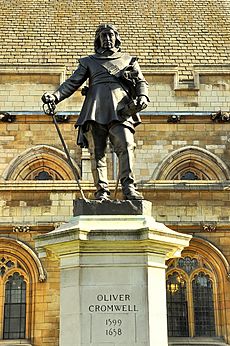
In 1776, one of the first ships in the American Continental Navy during the American Revolutionary War was named Oliver Cromwell.
The 19th-century engineer Sir Richard Tangye was a big fan of Cromwell. He collected many of Cromwell's writings and personal items. His collection included rare books, medals, paintings, and even "relics" like Cromwell's Bible, a button, and his death mask. After Tangye's death, the entire collection was given to the Museum of London, where it can still be seen.
In 1875, a statue of Cromwell by Matthew Noble was put up in Manchester outside the Manchester Cathedral. It was a gift to the city and was the first large outdoor statue of Cromwell in England. It showed him in battle clothes. However, it was not popular with local conservatives and the large Irish immigrant population.
In the 1890s, plans to put a statue of Cromwell outside Parliament became controversial. Irish politicians opposed public funding for it. The statue was eventually put up, but it was paid for privately by Lord Rosebery.
The debate about Cromwell continued into the 20th century. Before World War I, Winston Churchill twice suggested naming a British battleship HMS Oliver Cromwell. King George V vetoed the idea due to his personal feelings and because he felt it was unwise during a time of Irish political unrest. The Cromwell Tank was a British tank used in 1944. A steam locomotive built in 1951 was also named Oliver Cromwell.
Other public statues of Cromwell are in St Ives in Cambridgeshire and Warrington in Cheshire. An oval plaque at Sidney Sussex College, Cambridge, marks the final resting place of his head. It reads:
Near to
this place was buried
on 25 March 1960 the head of
OLIVER CROMWELL
Lord Protector of the Common-
wealth of England, Scotland &
Ireland, Fellow Commoner
of this College 1616-7
Images for kids
See also
 In Spanish: Oliver Cromwell para niños
In Spanish: Oliver Cromwell para niños
- Cromwell, a 1970 British historical drama film
- Republicanism in the United Kingdom
- Robert Walker, painted several portraits of Cromwell
- The Souldiers Pocket Bible, a booklet Cromwell gave to his army in 1643




